RENAULT TWINGO RS 2009 2.G Heating And Air Conditioning - Climate Control User Guide
Manufacturer: RENAULT, Model Year: 2009, Model line: TWINGO RS, Model: RENAULT TWINGO RS 2009 2.GPages: 99
Page 11 of 99
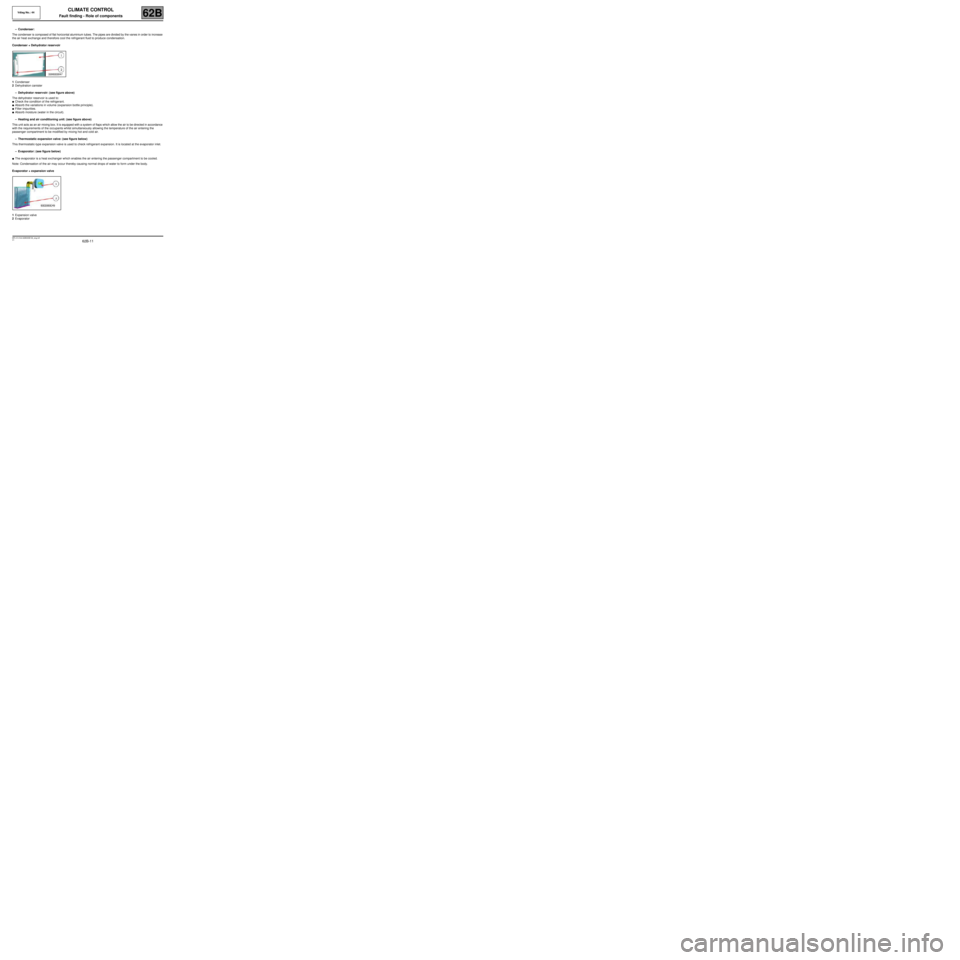
62B-11
MR-413-X44-62B000$138_eng.mif
V1
CLIMATE CONTROL
Fault finding - Role of components
Vdiag No.: 44
62B
–Condenser:
The condenser is composed of flat horizontal aluminium tubes. The pipes are divided by the vanes in order to increase
the air heat exchange and therefore cool the refrigerant fluid to produce condensation.
Condenser + Dehydrator reservoir
1Condenser
2Dehydration canister
–Dehydrator reservoir: (see figure above)
The dehydrator reservoir is used to:
●Check the condition of the refrigerant.
●Absorb the variations in volume (expansion bottle principle).
●Filter impurities.
●Absorb moisture (water in the circuit).
–Heating and air conditioning unit: (see figure above)
This unit acts as an air mixing box. It is equipped with a system of flaps which allow the air to be directed in accordance
with the requirements of the occupants whilst simultaneously allowing the temperature of the air entering the
passenger compartment to be modified by mixing hot and cold air.
–Thermostatic expansion valve: (see figure below)
This thermostatic-type expansion valve is used to check refrigerant expansion. It is located at the evaporator inlet.
–Evaporator: (see figure below)
●The evaporator is a heat exchanger which enables the air entering the passenger compartment to be cooled.
Note: Condensation of the air may occur thereby causing normal drops of water to form under the body.
Evaporator + expansion valve
1Expansion valve
2Evaporator
Page 12 of 99

62B-12
MR-413-X44-62B000$138_eng.mif
V1
CLIMATE CONTROL
Fault finding - Role of components
Vdiag No.: 44
62B
–High and low pressure pipes: (see figure below)
●The High Pressure and Low Pressure pipes are composed of rigid aluminium pipes and flexible pipes that
enable engine-related movements to be absorbed.
●Two filler valves (High Pressure and Low Pressure) can be accessed in order to fill (or drain) the refrigerant loop.
●The connections must be checked in the event of a refrigerant fluid leak.
Cold loop pipes
1Buffering capacity
2Expansion valve outlet
3Expansion valve inlet
4High pressure filler valve
5Low pressure filler valve
6Condenser inlet
7Condenser outlet
8Pressure sensor
9Compressor inlet
10 Compressor outlet
●HEATING COMPONENTS
–Heater matrix:
The external air entering the heating and air conditioning device (HVAC) is heated by the heater matrix.
–Passenger Compartment Heating Resistors (depending on the equipment): (see figure below)
The passenger compartment heating resistors (RCH) are electrical heating devices in the air conditioning unit. This
system is an additional heating system which operates when the engine is cold (when starting).
Page 13 of 99
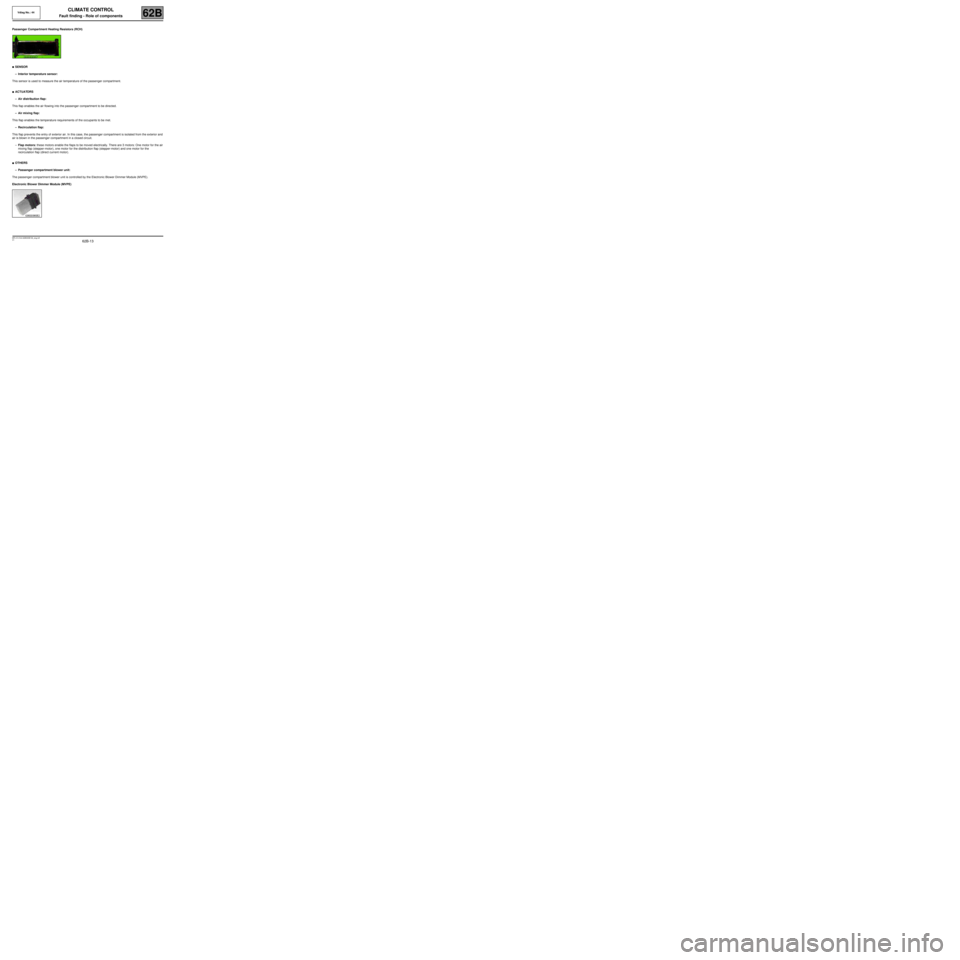
62B-13
MR-413-X44-62B000$138_eng.mif
V1
CLIMATE CONTROL
Fault finding - Role of components
Vdiag No.: 44
62B
Passenger Compartment Heating Resistors (RCH)
●SENSOR
–Interior temperature sensor:
This sensor is used to measure the air temperature of the passenger compartment.
●ACTUATORS
–Air distribution flap:
This flap enables the air flowing into the passenger compartment to be directed.
–Air mixing flap:
This flap enables the temperature requirements of the occupants to be met.
–Recirculation flap:
This flap prevents the entry of exterior air. In this case, the passenger compartment is isolated from the exterior and
air is blown in the passenger compartment in a closed circuit.
–Flap motors: these motors enable the flaps to be moved electrically. There are 3 motors: One motor for the air
mixing flap (stepper-motor), one motor for the distribution flap (stepper-motor) and one motor for the
recirculation flap (direct current motor).
●OTHERS
–Passenger compartment blower unit:
The passenger compartment blower unit is controlled by the Electronic Blower Dimmer Module (MVPE).
Electronic Blower Dimmer Module (MVPE)
Page 14 of 99
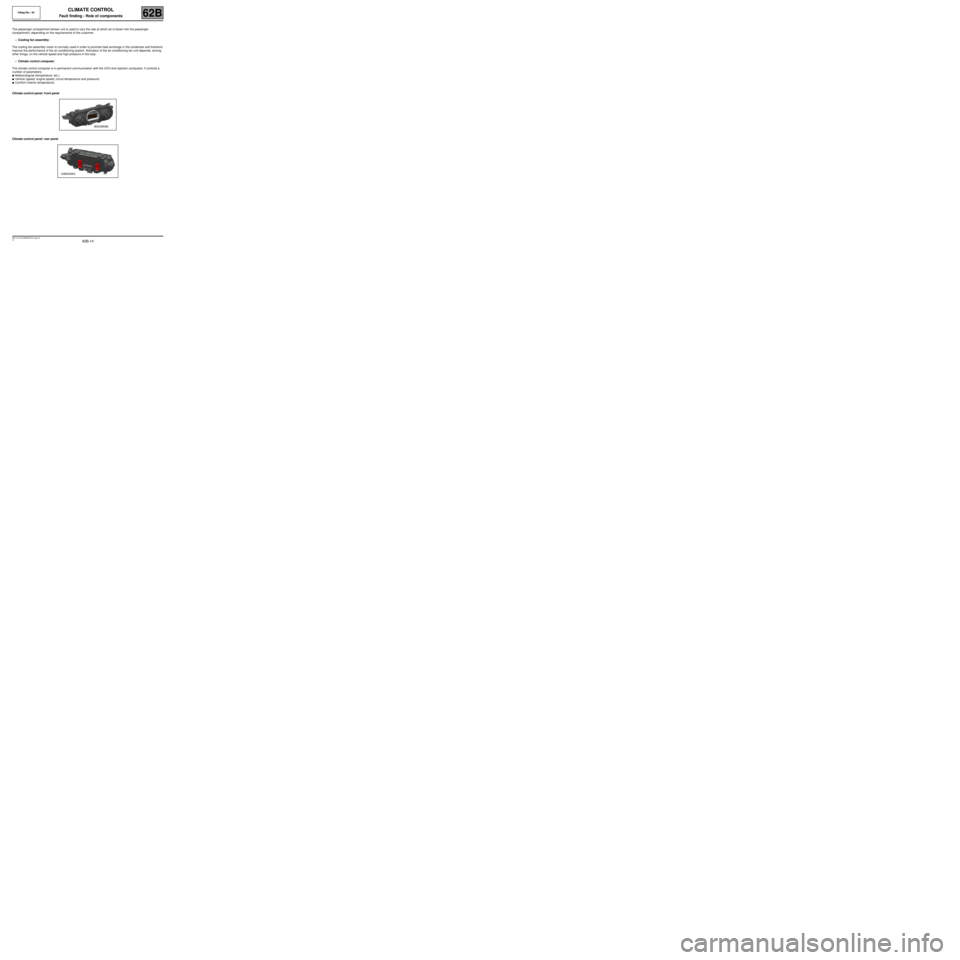
62B-14
MR-413-X44-62B000$138_eng.mif
V1
CLIMATE CONTROL
Fault finding - Role of components
Vdiag No.: 44
62B
The passenger compartment blower unit is used to vary the rate at which air is blown into the passenger
compartment, depending on the requirements of the customer.
–Cooling fan assembly:
The cooling fan assembly motor is normally used in order to promote heat exchange in the condenser and therefore
improve the performance of the air conditioning system. Activation of the air conditioning fan unit depends, among
other things, on the vehicle speed and high pressure in the loop.
–Climate control computer:
The climate control computer is in permanent communication with the UCH and injection computers. It controls a
number of parameters:
●Meteorological (temperature, etc.)
●Vehicle (speed, engine speed, circuit temperature and pressure)
●Comfort (interior temperature).
Climate control panel: front panel
Climate control panel: rear panel
Page 15 of 99
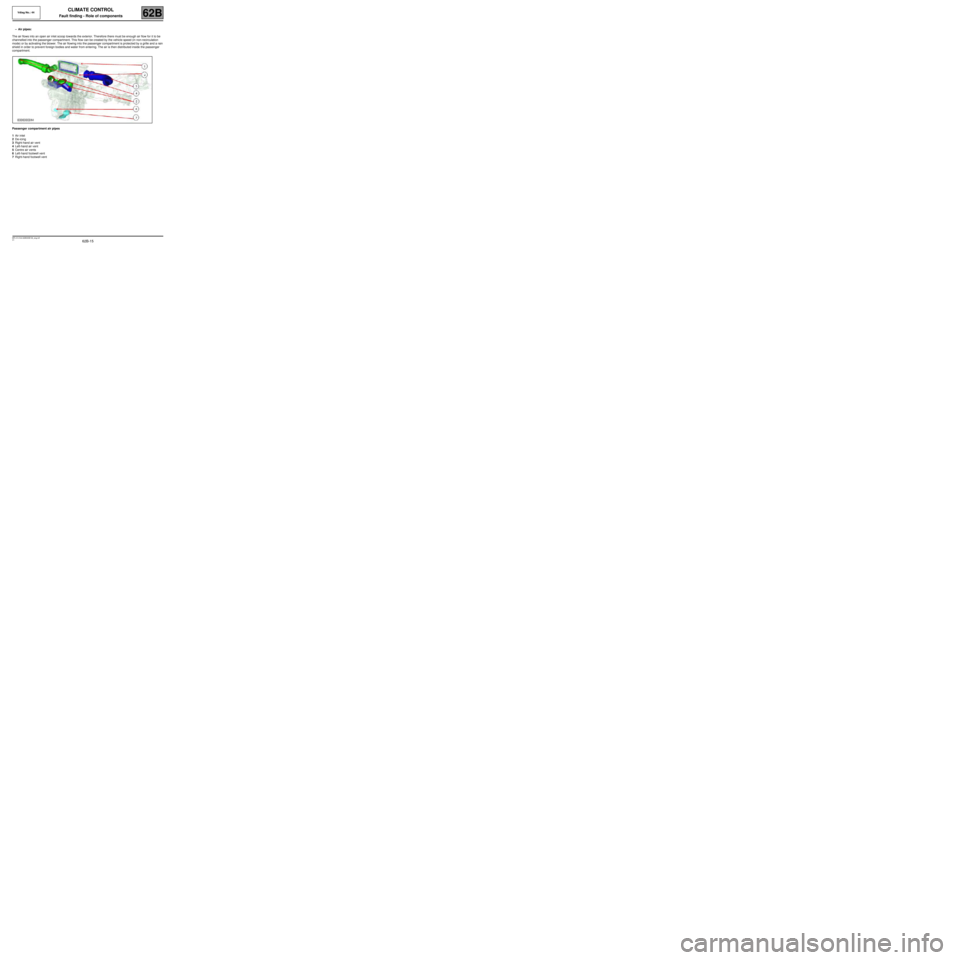
62B-15
MR-413-X44-62B000$138_eng.mif
V1
CLIMATE CONTROL
Fault finding - Role of components
Vdiag No.: 44
62B
–Air pipes:
The air flows into an open air inlet scoop towards the exterior. Therefore there must be enough air flow for it to be
channelled into the passenger compartment. This flow can be created by the vehicle speed (in non-recirculation
mode) or by activating the blower. The air flowing into the passenger compartment is protected by a grille and a rain
shield in order to prevent foreign bodies and water from entering. The air is then distributed inside the passenger
compartment.
Passenger compartment air pipes
1Air inlet
2De-icing
3Right-hand air vent
4Left-hand air vent
5Centre air vents
6Left-hand footwell vent
7Right-hand footwell vent
Page 16 of 99
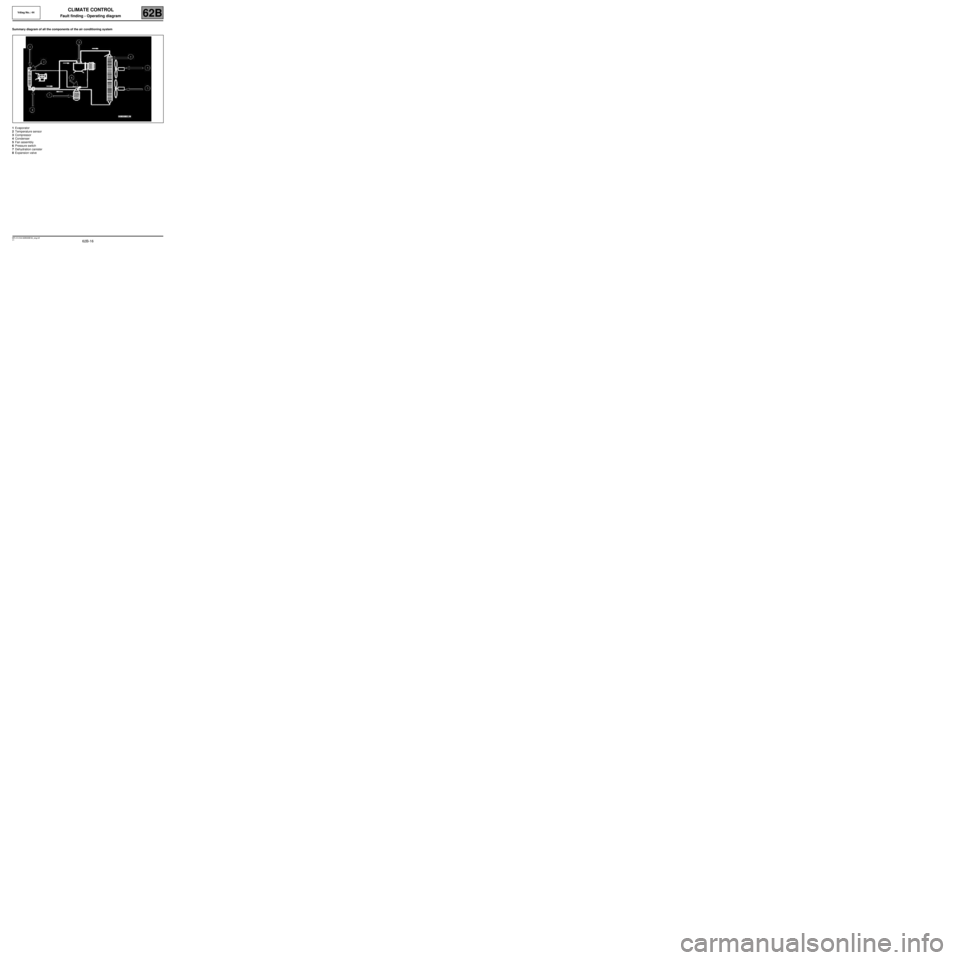
62B-16
MR-413-X44-62B000$184_eng.mif
V1
62B
CLIMATE CONTROL
Fault finding - Operating diagram
Summary diagram of all the components of the air conditioning system
1Evaporator
2Temperature sensor
3Compressor
4Condenser
5Fan assembly
6Pressure switch
7Dehydration canister
8Expansion valve
Vdiag No.: 44
MR-413-X44-62B000$184_eng.mif
Page 17 of 99
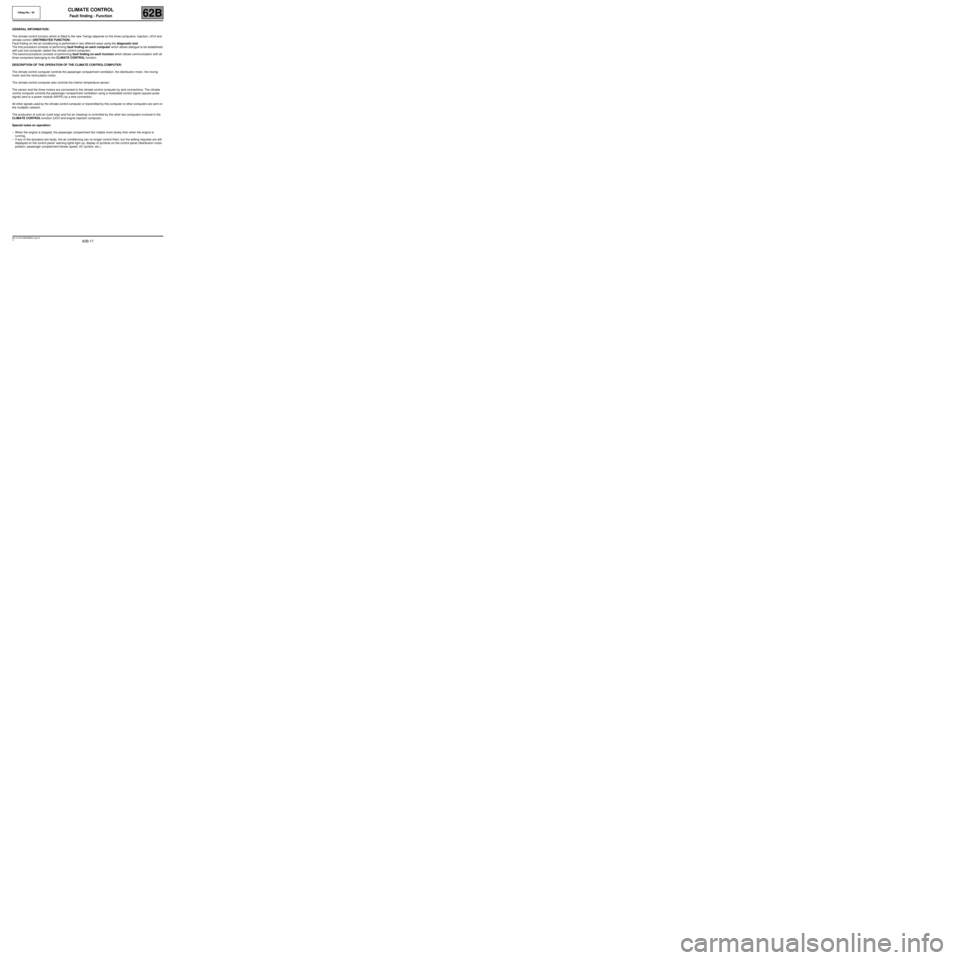
62B-17
MR-413-X44-62B000$230_eng.mif
V1
62B
CLIMATE CONTROL
Fault finding - Function
GENERAL INFORMATION:
The climate control function which is fitted to the new Twingo depends on the three computers: injection, UCH and
climate control (DISTRIBUTED FUNCTION).
Fault finding on the air conditioning is performed in two different ways using the diagnostic tool.
The first procedure consists of performing fault finding on each computer which allows dialogue to be established
with just one computer (select the climate control computer).
The second procedure consists of performing fault finding on each function which allows communication with all
three computers belonging to the CLIMATE CONTROL function.
DESCRIPTION OF THE OPERATION OF THE CLIMATE CONTROL COMPUTER:
The climate control computer controls the passenger compartment ventilation, the distribution motor, the mixing
motor and the recirculation motor.
The climate control computer also controls the interior temperature sensor.
The sensor and the three motors are connected to the climate control computer by wire connections. The climate
control computer controls the passenger compartment ventilation using a modulated control signal (square pulse
signal) sent to a power module (MVPE) by a wire connection.
All other signals used by the climate control computer or transmitted by this computer to other computers are sent on
the multiplex network.
The production of cold air (cold loop) and hot air (heating) is controlled by the other two computers involved in the
CLIMATE CONTROL function (UCH and engine injection computer).
Special notes on operation:
–When the engine is stopped, the passenger compartment fan rotates more slowly than when the engine is
running.
–If any of the actuators are faulty, the air conditioning can no longer control them, but the setting requests are still
displayed on the control panel: warning lights light up, display of symbols on the control panel (distribution motor
position, passenger compartment blower speed, AC symbol, etc.).
Vdiag No.: 44
MR-413-X44-62B000$230_eng.mif
Page 18 of 99
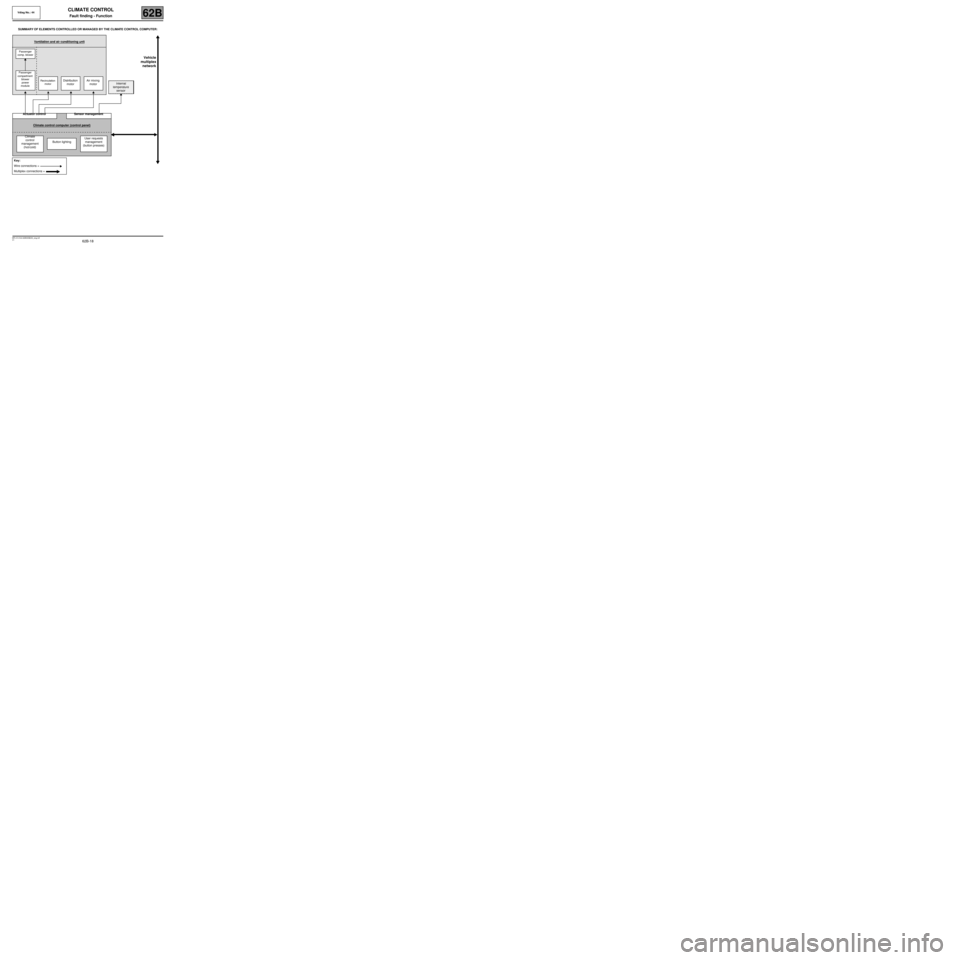
62B-18
MR-413-X44-62B000$230_eng.mif
V1
Vdiag No.: 44CLIMATE CONTROL
Fault finding - Function62B
Vehicle
multiplex
network
Internal
temperature
sensor
SUMMARY OF ELEMENTS CONTROLLED OR MANAGED BY THE CLIMATE CONTROL COMPUTER:
Ventilation and air conditioning unit
Passenger
comp. blower
Passenger
compartment
blower
power
module
Recirculation
motorDistribution
motorAir mixing
motor
Actuator control Sensor management
Climate control computer (control panel)
Climate
control
management
(hot/cold)Button lightingUser requests
management
(button presses)
Key:
Wire connections =
Multiplex connections =
Page 19 of 99
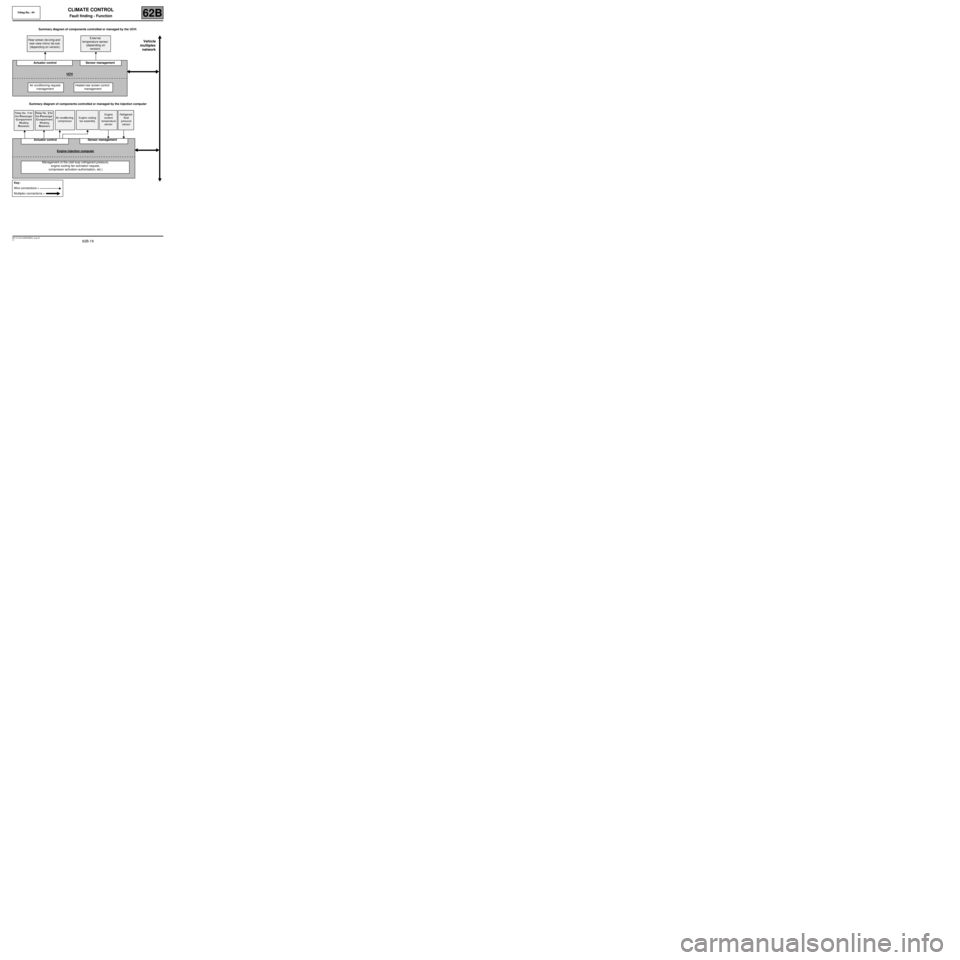
62B-19
MR-413-X44-62B000$230_eng.mif
V1
Vdiag No.: 44CLIMATE CONTROL
Fault finding - Function62B
Vehicle
multiplex
network
Summary diagram of components controlled or managed by the UCH:
Summary diagram of components controlled or managed by the injection computer Rear screen de-icing and
rear-view mirror de-icer
(depending on version)External
temperature sensor
(depending on
version)
Actuator control Sensor management
UCH
Air conditioning request
managementHeated rear screen control
management
Relay No. 1 for
the Passenger
Compartment
Heating
ResistorsRelay No. 2 for
the Passenger
Compartment
Heating
ResistorsAir conditioning
compressorEngine cooling
fan assemblyEngine
coolant
temperature
sensorRefrigerant
fluid
pressure
sensor
Actuator control Sensor management
Engine injection computer
Management of the cold loop (refrigerant pressure,
engine cooling fan activation request,
compressor activation authorisation, etc.)
Key:
Wire connections =
Multiplex connections =
Page 20 of 99
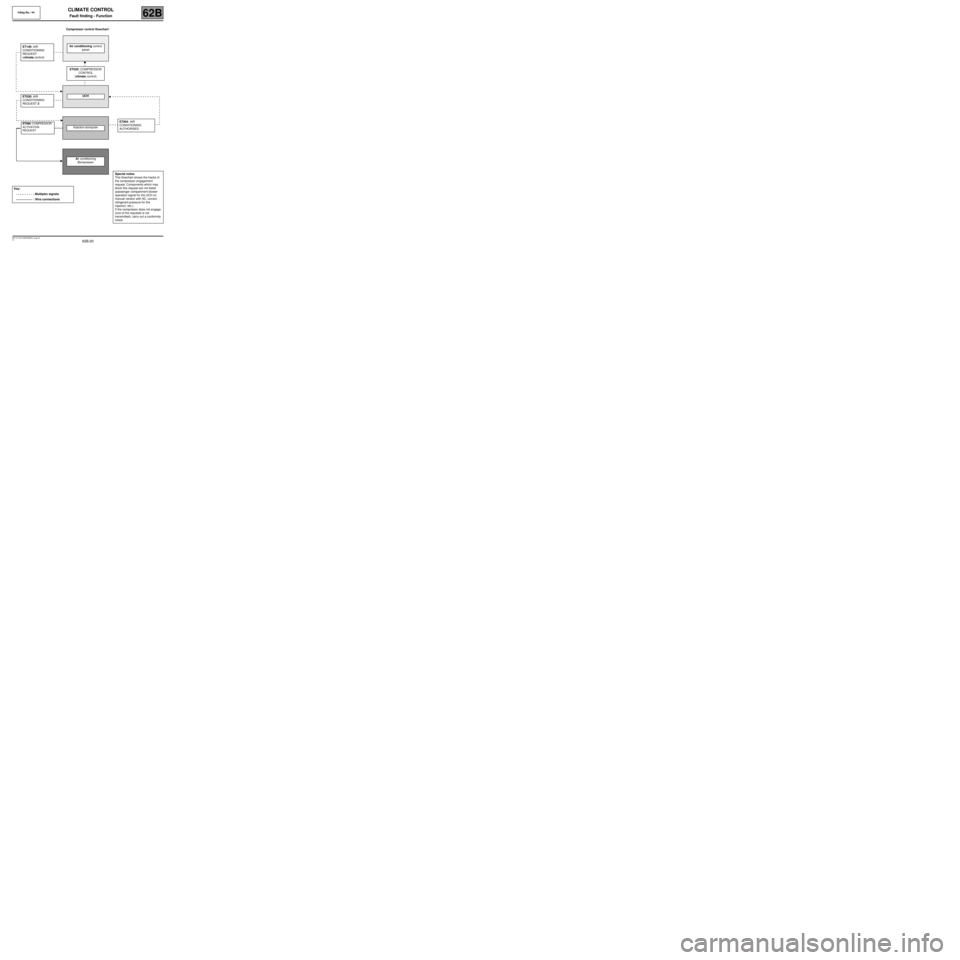
62B-20
MR-413-X44-62B000$230_eng.mif
V1
Vdiag No.: 44CLIMATE CONTROL
Fault finding - Function62B
ET004: AIR
CONDITIONING
AUTHORISED
Special notes:
This flowchart shows the tracks of
the compressor engagement
request. Components which may
block this request are not listed
(passenger compartment blower
operation signal for the UCH on
manual version with AC, correct
refrigerant pressure for the
injection, etc.).
If the compressor does not engage
(one of the requests is not
transmitted): carry out a conformity
check.
Compressor control flowchart:
ET140: AIR
CONDITIONING
REQUEST
(climate control)Air conditioning control
panel
ET020: COMPRESSOR
CONTROL
(climate control)
ET030: AIR
CONDITIONING
REQUEST 2UCH
ET088: COMPRESSOR
ACTIVATION
REQUEST
Injection computer
Air conditioning
Compressor
Key:
: Multiplex signals
: Wire connections